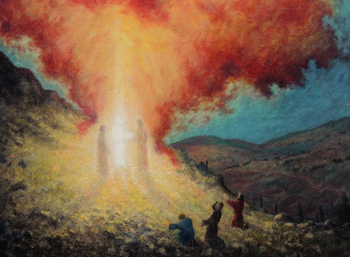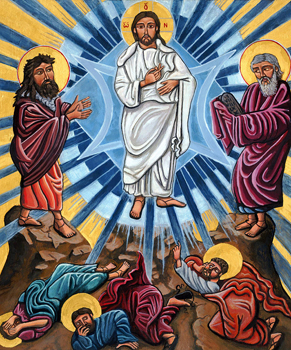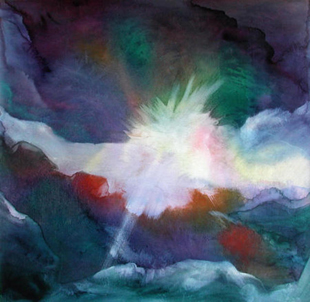For Sunday February 27, 2022
Lectionary Readings (Revised Common Lectionary, Year C)
Exodus 34:29-35
Psalm 99
2 Corinthians 3:12-4:2
Luke 9:28-36, (37-43a)
In one of his many beautiful meditations, Franciscan priest and mystic, Richard Rohr challenges “mountaintop” religiosity. That is, a religiosity that divides the sacred and special from the secular and ordinary: “We have created an artificial divide or dualism between the spiritual and the so-called non-spiritual,” Rohr writes. “This dualism is precisely what Jesus came to reveal as a lie. The Incarnation proclaims that matter and spirit have never been separate. Jesus came to tell us that these two seemingly different worlds are — and always have been — one.”
I agree with Rohr completely. But I struggle to live with the “non-dual” consciousness he advocates. That is, I struggle to see God in the mundane. In the muck and mess of my regular, “unspectacular” life.
This has always been true, but it feels acutely true now, two long years into the Covid-19 pandemic. Where is God in the daily death tolls? In the isolation, grief, and trauma the world continues to endure? In what sense are the hardships and losses of these days, “sacred?”
I ask because it's Transfiguration Sunday — the apex of the liturgical season we call Epiphany. For weeks, we’ve caught hints and glimpses of the holy in Jesus’s early ministry. A dove descending from the heavens. Water becoming fine wine. A fishing net nearly bursting from a miraculous catch. But today, we see Jesus in his unveiled glory. Today, we see the view from the mountaintop.
All three Synoptic Gospels tell the story of the Transfiguration — and all three conclude the story with the healing of a “demon-possessed” boy down in the valley. I find this pairing instructive, because it illustrates precisely what Rohr argues. What happens in the ordinary trials and tribulations of human life is just as God-infused as the experiences that occur on faith’s mountaintops.
 |
Unfortunately, we don’t always believe this. We fall into the habit of measuring the depth and success of our faith by the number of spectacular epiphanies we can claim. Have we “felt the Spirit” in Sunday worship? Has Jesus “spoken” to us? Have we seen visions? Encountered God’s living presence in our dreams? Has God answered our prayers in the specific and concrete ways we desire?
Most of the time, my answer to these questions is “no.” Or at best, “I'm not sure.” From there, it’s a short distance to feeling like a spiritual failure. Mature Christians (we assume), have frequent experiences akin to Peter’s on the mountaintop. They see visions and dream dreams. Jesus reveals himself to them in spectacular ways they can’t describe or deny.
It's not true, of course. This hierarchy of holiness. This way of measuring piety. And yet it lingers in us — this yearning for a particular kind of affective experience to come along on a regular basis, and validate our faith. The truth is, I like and want and crave and covet Christian mountaintops. And stories like the Transfiguration don't help. If Peter could see Jesus in his unfiltered glory, why can't I?
The danger of “God on the mountaintop” Christianity is that it prompts me to compartmentalize my life. As if God is somehow more present during a rousing choral anthem, a stirring sermon, or a silent retreat in a seaside monastery, than God is when I'm doing the laundry, buying my groceries, or sitting in bumper-to-bumper traffic.
In its worst iteration, mountaintop Christanity is addictive, leading us to spend our days pursuing a “high” we conflate with spiritual success. When we don’t experience that high, we feel empty, unloved, angry, or bored. Meanwhile, we don't notice the ever-present God in whom we actually live and move and have our being. Desperate for the mountain, we miss the God of the valley, the conference room, the pharmacy, the school yard. Worshiping the extraordinary doesn’t make for a healthy faith.
 |
Of course, whenever we think we have God figured out, it’s good to be reminded that we’re wrong. Whenever we try to stuff Jesus into a theological, cultural, or political box for our own convenience, it’s good to have that box blown open with an encounter akin to what Peter experiences during the Transfiguration. Whenever we grow complacent, self-righteous, or lazy in our lives of faith, it’s good to be brought to our knees by a God whose thoughts are not our thoughts, and whose ways are not our ways. There are good reasons to encounter Jesus on the mountaintop.
The problem in the Transfiguration story is that as soon as Peter experiences a spiritual high, he tries to hoard it. What I hear in his plan to “make dwellings” is an understandable but misguided attempt to contain, domesticate, protect, and possess the sublime. To harness the holy. To make the fleeting permanent. To keep Jesus shiny, beautiful, and safe up on a mountain. After all, everything is so good up there. So clear. So bright. So unmistakably spiritual. Why not stay forever?
Well, because God is just as present, active, engaged, and glorious down in the valley as God is in the visions of saints, clouds, and shadows Peter experiences in the high places. In fact, what Peter eventually learns is that the compassionate heart of God is most powerfully revealed amidst the broken, the sinful, the suffering, and the despairing. The kingdom of God shines most brightly against the backdrop of the parent who grieves, the child who cries, the “demons” who oppress, and the disciples who try but fail to manufacture the holy. God’s strength is made perfect in our weakness. God’s beauty is best contained in broken vessels. We might not like this aspect of faith, but it's an aspect that has much to teach us.
To me, it’s interesting — and sobering — to notice that the Transfiguration doesn’t grant Jesus’s disciples the faith or the strength to heal the suffering boy, or comfort his heartbroken father. What they experience during their spiritual high doesn’t magically translate into vibrant, transformative faith down below. Which is to say, if we’re sitting around waiting for more mountaintop experiences to mature and deepen our faith before we love and serve God’s children in the valley, then we need to rethink our strategy immediately. The discipline of the valley happens in the valley. Finding God in the ordinary requires dwelling in the ordinary. We learn quotidian holiness only in the seconds, minutes, hours, and days of our “regular” lives. There are no shortcuts. God is not in the business of offering us permanent real estate on the mountaintops.
 |
So here's the great challenge of the Christian life: can we speak glory to agony, and agony to glory? Can we hold the mountain and the valley as one — denying neither, and embracing both? Can we do this hard work out of love and compassion for each other, so that no one among us is left to hurt and suffer in the places where God's presence is harder to discern?
I still yearn for mountaintop experiences, and that’s okay. They’ll come and go according to God’s timing, not according to my micromanagement. In that sense, sublime spiritual experiences are easy; they require little from me. I can’t control them. What’s hard is consenting to follow Jesus back down the mountain. What’s essential is finding Jesus on the long road. In the deep sorrow. At the heart of the unanswered prayer. What's key is discerning the presence of God in the spaces between the light and the shadow.
With Transfiguration Sunday, we come to the end of another liturgical season. Having seen the brightness of Epiphany, we prepare now for the holy darkness of Lent. We can’t know ahead of time what mountains and valleys lie ahead. We can’t predict how God will speak, and in what guise Jesus might appear. But we can trust in this: whether on the brightest mountain, or in the darkest valley, Jesus abides. Even as he blazes with holy light, his hand remains warm and solid on our shoulders. Even when everything else we're counting on disappears, Jesus remains among us — Jesus alone.
So don’t be afraid to come down from the mountain. Keep looking and listening for the sacred, no matter where the journey takes you. Because Jesus is present everywhere. Both the mountain and the valley belong to him. He is Lord of all.
Debie Thomas: debie.thomas1@gmail.com
Image credits: (1) FineArtAmerica.com; (2) FineArtAmerica.com; and (3) AbsoluteArts.com.





